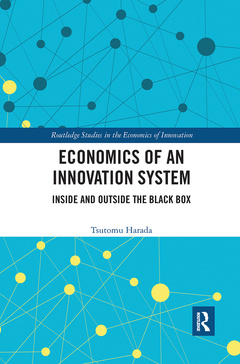Description
Economics of an Innovation System
Inside and Outside the Black Box
Routledge Studies in the Economics of Innovation Series
Author: Harada Tsutomu
Language: English
Subject for Economics of an Innovation System:
Keywords
International Input Output Association; Keynesian DSGE Model; Endogenous structural change; Constant Relative Risk Aversion Type; Endogenous innovation; Keynesian DSGE; Innovation input-output matrices; Government Expenditure Shock; Multi-sector innovation system; Stochastic Dynamic Programming Problem; Path-dependent endogenous innovation; AK Model; National Innovation Systems; Intermediate Goods Firms; Final Good Firm; Innovation Probability; Optimal Interior Solution; Increase Innovation Performance; User Sector; Organization Specific Routines; Relation Specific Investment; National Innovation System; Investment Adjustment Cost; Unbalanced Growth Strategy; Innovation Linkages; Balanced Growth Path; Bottleneck Technology; International Technology Transfer; Endogenous Growth Literature; TFP Growth
Publication date: 09-2020
· 15.6x23.4 cm · Paperback
Publication date: 03-2019
· 15.6x23.4 cm · Hardback
Description
/li>Contents
/li>Readership
/li>Biography
/li>
Existing literature looks at national innovation systems from the perspective of either "inside the black box" or "outside the black box". This is the first book that analyzes both the inside and outside of the black box using a general equilibrium framework.
The book looks at what is outside the black box and provides models of path-dependent endogenous growth; examines the dynamics of the black box from the intersectoral perspective of the economy; and proposes an innovation flow matrix. It also takes into account both business cycles and endogenous innovation in the unified New Keynesian dynamic stochastic general equilibrium (DSGE) model and examines how business cycles and other policy shocks affect endogenous innovation.
The unified treatment of the national innovation system from perspectives both inside and outside the black box using rigorous economic models and empirical analyses makes this an enlightening work, shedding new light on innovation economics.
Introduction Part I: Outside the Black Box: Path-dependent Growth 1. Path-dependent Economic Growth with Technological Trajectory 2. Path-dependent Economic Progress and Regress 3. Division of Labor in Innovation between General Purpose Technology and Special Purpose Technology Part II: Dynamics of the Black Box: Intersectoral Growth 4. Advantages of Backwardness and Forwardness with Shifting Comparative Advantage 5. Changing Productive Relations, Linkage Effects and Industrialization 6. Structural Change and Economic Growth with Relation-specific Investment Part III: Inside the Black Box: Innovation Mechanism 7. Focusing Device as Innovation Mechanism and Cluster Growth 8. Managing Innovation Probabilities through Focusing Device 9. Three-step Flow of Knowledge Communication Part IV: Measuring the Black Box: Innovation Flow Matrix and Policy Evaluation 10. Model of Intersectoral Flow of Technology using Technology and Innovation flow Matrices 11. Estimating Innovation Flow Matrix and Innovation Linkages in the East Asian region and the United States 12. Endogenous Innovation and Macroeconomic Shocks in a New Keynesian DSGE Model
Tsutomu Harada is Professor of Industrial Economics at Kobe University, Japan. He received a PhD in Economics from Stanford University and a PhD in Business Administration from Kobe University. His research interests include innovation economics, technology management, and strategy.




